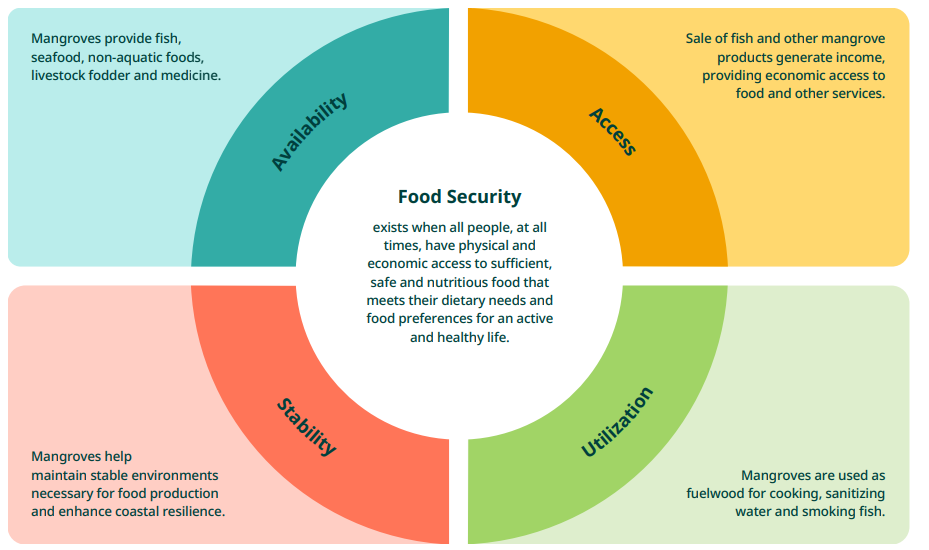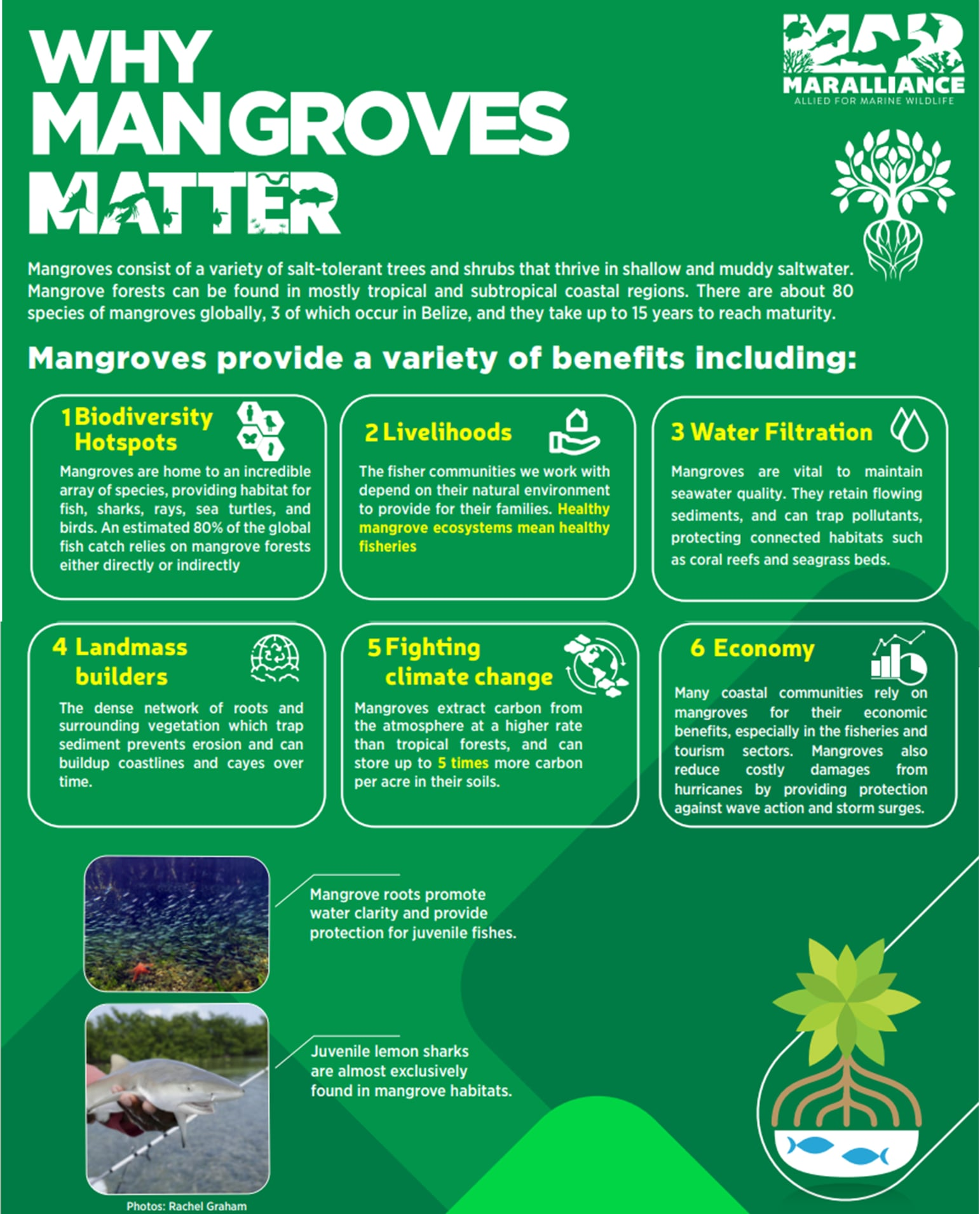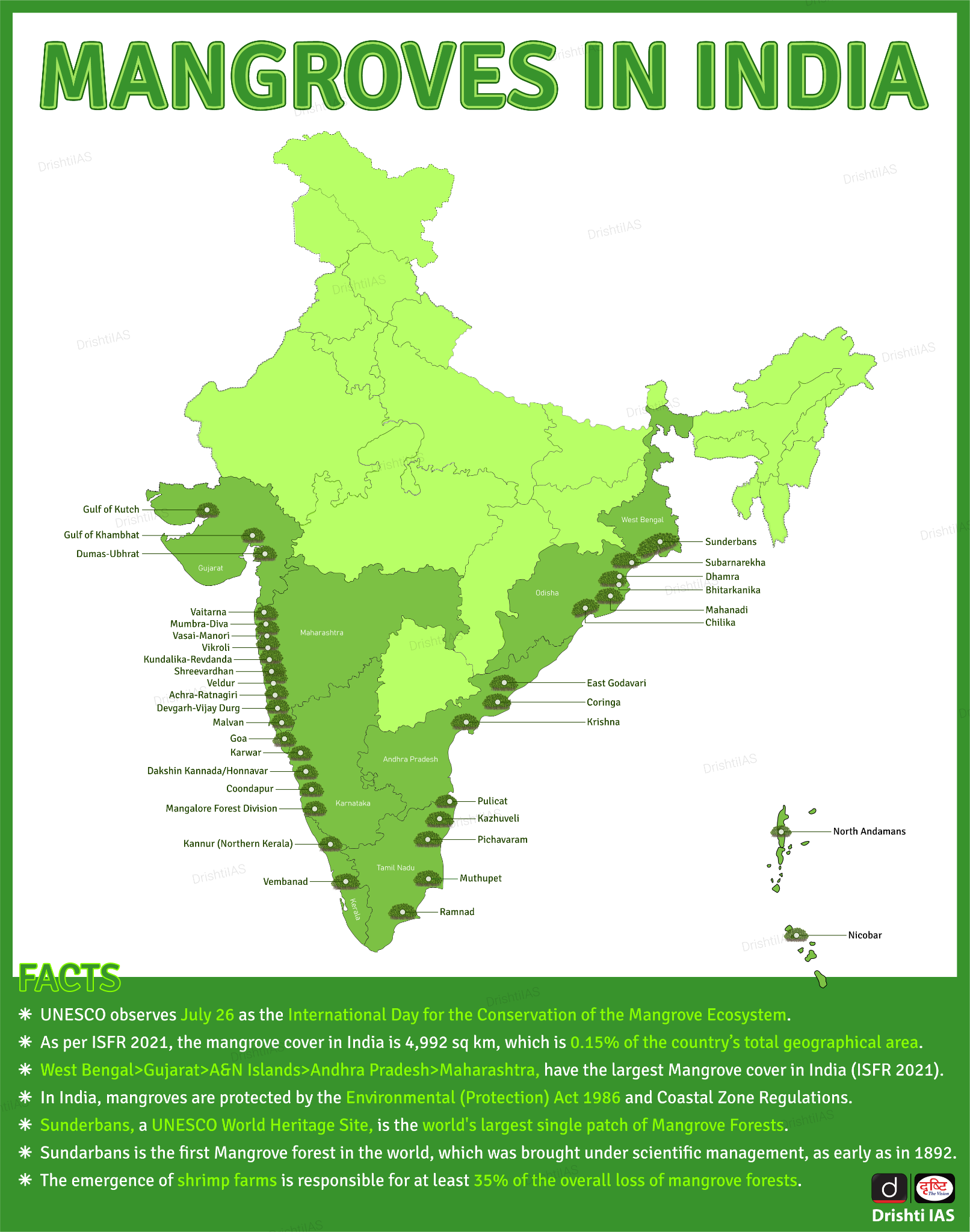Biodiversity & Environment
The State of the World's Mangroves 2024
- 01 Aug 2024
- 11 min read
For Prelims: The State of the World's Mangroves 2024, Global Mangrove Alliance, World Mangrove Day, Global Mangrove Watch, Aquaculture, Sea-level rise, IUCN Red List, Ecosystem services, Carbon storage, Ecotourism, Kunming-Montreal Global Biodiversity Framework
For Mains: Challenges to Mangroves, Status of Mangroves
Why in News?
Recently, a report titled "The State of the World's Mangroves 2024" was released by the Global Mangrove Alliance (GMA) on World Mangrove Day (26 July).
- The GMA is the preeminent alliance of 100-plus members driving the conservation and restoration for the world’s mangroves.
What are the Key Benefits of the Mangroves as Per the State of the World's Mangroves 2024 Report?
- About:
- The latest world map (GMW v4.0), developed by the Global Mangrove Watch, provides a sixfold improvement in spatial resolution.
- It maps 147,256 km² of mangroves in 2020, adding data for six new territories.
- Southeast Asia holds about one-third of the world's mangroves, with Indonesia alone accounting for 21%.
- The latest world map (GMW v4.0), developed by the Global Mangrove Watch, provides a sixfold improvement in spatial resolution.
- Key Benefits of Mangroves:
-
Carbon Storage: Mangroves hold, on average, a remarkable 394 tonnes of carbon per hectare in their living biomass and in the top meter of soil.
-
Some mangrove areas, like in the Philippines, the average values are over 650 tonnes of carbon per hectare.
-
-
Biodiversity: Mangroves are home to a tremendous diversity of species, reflecting their ecotone nature.
-
Over 5,700 plant and animal species, across 21 phyla, have been recorded in Indian mangroves alone.
-
-
Flood Reduction: Flooding is the most frequently occurring natural disaster worldwide and is exacerbated by climate change.
-
Mangroves reduce flood depths by 15-20%, and over 70% in some areas.
-
- Food Security: Mangroves support nearly 800 billion young fish, prawns, bivalves, and crabs annually, crucial for global fisheries.
- Cultural Significance: Mangrove species are widely used in traditional medicine, providing health benefits to local populations.
-
What are the Key Highlights in the Report Regarding India?
- Mangrove Cover in India: In India West Bengal holds the largest mangrove area followed by Gujarat, majorly located in the Gulf of Kutch and Gulf of Khambhat.
-
Biodiversity in the Mangrove Ecosystems of India: Mangrove ecosystems of India have perhaps the highest record of biodiversity of any country, with a total of 5,746 species. Of these, 4,822 species (84%) are animals.
-
Critically Endangered and Vulnerable Mangroves: Natural mangrove forests on the southern Indian coast are critically endangered, particularly in the Lakshadweep archipelago and Tamil Nadu, due to rising sea levels from global warming.
-
The report identifies shrimp aquaculture as a major driver of mangrove loss, highlighting its expansion in states like Andhra Pradesh, West Bengal, and Gujarat.
- Mangroves on the western coast, extending from Gujarat to Kerala, are vulnerable to collapse due to human activities like shrimp aquaculture and natural threats such as tropical storms.
- Conservation challenges in the Gulf of Cambay (Khambhat) include severe grazing and lopping during the flowering season, which hinders natural regeneration and damages the mangrove stock.
-
-
Government Initiatives: The Union government has launched the Mangrove Initiative for Shoreline Habitats & Tangible Incomes (MISHTI) programme to augment mangrove cover by planting mangroves in 540 sq km across 11 states and two Union territories.
- Corporate involvement includes six major corporations signing MoUs with the Gujarat forest department to plant mangroves in 30 sq km.
What are the Challenges Highlighted in the Report?
- Conversion to aquaculture (26%), oil palm plantations and rice cultivation together explain 43% of mangrove losses between 2000 and 2020.
- The expansion of oil palm plantations and rice cultivation significantly contributes to the destruction of mangrove forests.
- Logging for timber and charcoal production leads to significant mangrove degradation.
- Natural retraction, influenced by climate change, sediment shifts, and sea-level rise, also impacted 26% of mangrove areas.
- Increasing sea levels threaten mangrove habitats, especially those with limited freshwater and sediment input.
- More frequent and intense cyclonic storms cause significant damage to mangrove ecosystems.
- Regional breakdowns highlight very diverse patterns of change, with human impacts dominating change in Africa, Asia, and North and Central America.
- Despite efforts, only 40% of the world's remaining mangrove forests are in protected areas. Some countries, like Malaysia and Myanmar, have less than 5% protection.
- The IUCN Red List identifies that half of the world’s mangrove provinces are threatened, with climate change being a significant exacerbating factor.
- Pollution from oil spills (8.2%), particularly in regions like the Niger Delta, poses severe risks to mangrove health and regeneration.
- Securing adequate financing for mangrove conservation remains a challenge.
What are the Steps Suggested in the Report for the Protection of Mangroves?
- Six Guiding Principles for Successful Mangrove Restoration:
- Principle 1: Safeguard nature and maximise biodiversity.
- Protect the remaining intact mangrove ecosystems, enhance their resilience, and implement science-based ecological restoration protocols.
- Policy frameworks like the Kunming-Montreal Global Biodiversity Framework are crucial in driving international conservation efforts
- Protect the remaining intact mangrove ecosystems, enhance their resilience, and implement science-based ecological restoration protocols.
- Principle 2: Employ the best information and practices.
- Use the best available science-based knowledge, including Indigenous, traditional, and local knowledge, for mangrove interventions.
- Case studies from regions like the Philippines, Colombia, and Kenya highlight successful community-led restoration projects.
- Use the best available science-based knowledge, including Indigenous, traditional, and local knowledge, for mangrove interventions.
- Principle 3: Empower people and address their needs.
- Implement, in all aspects of project design, social safeguards that operate locally and contextually to protect and enhance community member rights, knowledge, and leadership to achieve fair and equitable benefit sharing.
- Principle 4: Align to the broader context – operate locally and contextually.
- Operate in the local context, including cultural customs, resource use, management, and ownership regimes, while taking a land and seascape approach and aligning to international trends and their local implications.
- Principle 5: Design for sustainability.
- Create sustainable mangrove projects and programs that are inclusive of how these initiatives will last into the future, including considerations for financing, threat abatement, community stewardship, and climate change.
- Principle 6: Mobilize High-integrity capital.
- Ensure capital flows at the scale needed and allow funding to be distributed to ready-to-scale projects.
- Innovative financial tools, including carbon credits and mangrove insurance, are essential for supporting conservation actions.
- Ensure capital flows at the scale needed and allow funding to be distributed to ready-to-scale projects.
- Principle 1: Safeguard nature and maximise biodiversity.
- Expand Protected Areas: The Global Mangrove Alliance aims to halt mangrove loss, restore half of the world's lost mangroves, and double protection by 2030.
- Increase the percentage of mangrove areas under legal protection. The Global Mangrove Alliance aims to double the protection to 80% by 2030.
- Other Effective Area-Based Conservation Measures (OECMs): Implement OECMs that integrate biodiversity into sectors like food and water security, even if conservation is not the primary objective.
|
Drishti Mains Question: Q. Discuss the current state of mangrove forests in India. What are the major challenges faced by these ecosystems, and what measures can be taken to address them? |
UPSC Civil Services Examination, Previous Year Question (PYQ)
Prelims:
Q. “Leaf litter decomposes faster than in any other biome and as a result the soil surface is often almost bare. Apart from trees, the vegetation is largely composed of plant forms that reach up into the canopy vicariously, by climbing the trees or growing as epiphytes, rooted on the upper branches of trees.” This is the most likely description of (2021)
(a) coniferous forest
(b) dry deciduous forest
(c) mangrove forest
(d) tropical rainforest
Ans: (d)
Q. Which one of the following regions of India has a combination of mangrove forest, evergreen forest and deciduous forest? (2015)
(a) North Coastal Andhra Pradesh
(b) South-West Bengal
(c) Southern Saurashtra
(d) Andaman and Nicobar Islands
Ans: (d)
Q. Two important rivers – one with its source in Jharkhand (and known by a different name in Odisha), and another, with its source in Odisha – merge at a place only a short distance from the coast of Bay of Bengal before flowing into the sea. This is an important site of wildlife and biodiversity and a protected area. Which one of the following could be this? (2011)
(a) Bhitarkanika
(b) Chandipur-on-sea
(c) Gopalpur-on-sea
(d) Simlipal
Ans: (a)
Q. Recently, which one of the following was included in the UNESCO’s World Heritage list? (2009)
(a) Dilwara Temple
(b) Kalka-Shimla Railway
(c) Bhiterkanika Mangrove Area
(d) Visakhapatnam to Araku valley railway line
Ans: (b)
Mains:
Q. Discuss the causes of depletion of mangroves and explain their importance in maintaining coastal ecology. (2019)
Q. What is wetland? Explain the Ramsar concept of ‘wise use’ in the context of wetland conservation. Cite two examples of Ramsar sites from India. (2018)













